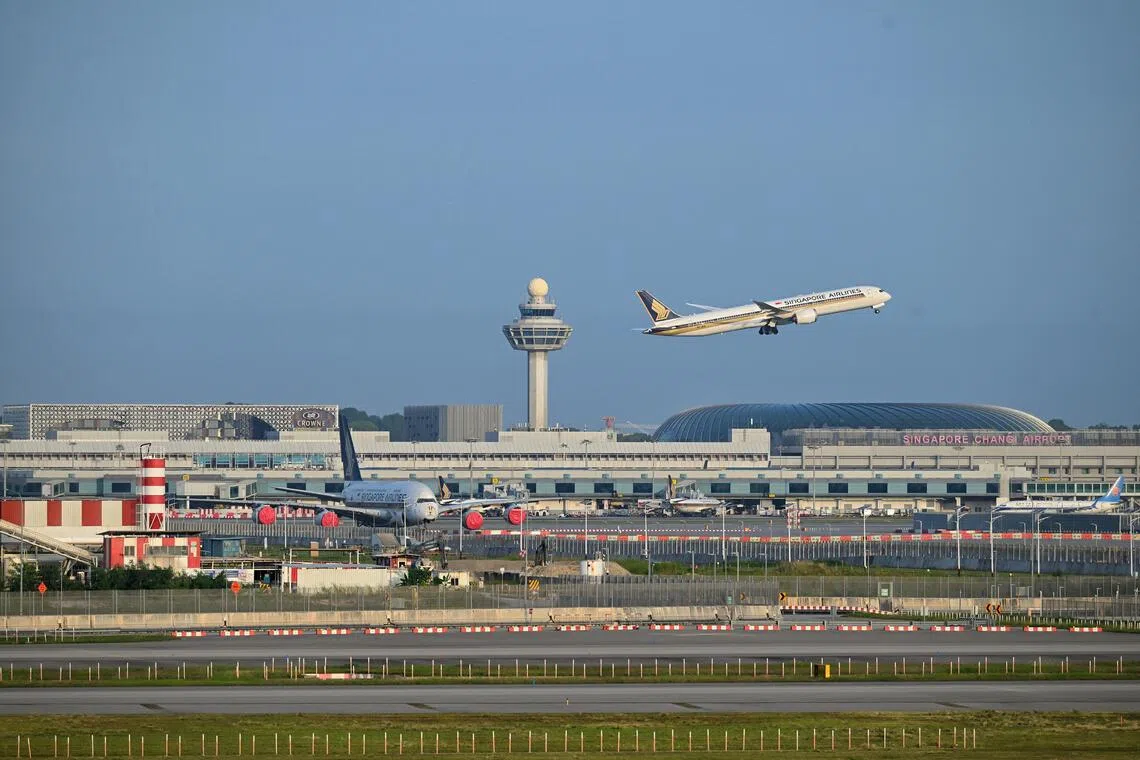Singapore’s levy to boost use of greener jet fuel not suitable elsewhere as it may dampen air travel: Iata
Sign up now: Get ST's newsletters delivered to your inbox

Parliament passed a Bill on Oct 14 to impose a fixed levy on all departing flights from 2026 to support airlines’ use of sustainable aviation fuel.
PHOTO: ST FILE
Follow topic:
- Singapore's SAF levy on travellers may dampen air travel, but IATA acknowledges its suitability for Singapore's unique circumstances and SAF production limits.
- IATA favours government incentives for SAF adoption, as in the US, and strongly opposes mandates due to limited SAF supply, driving up prices.
- IATA is uncertain about meeting ICAO’s 2030 emissions reduction target, citing slow SAF production and high costs, urging significant investment.
AI generated
HONG KONG - Singapore’s decision to impose a levy on travellers to raise the use of greener jet fuel may have a “dampening effect on air travel”, and the International Air Transport Association (Iata) may not recommend such a policy elsewhere, said the body’s official.
However, given Singapore’s land constraints and limited capacity in producing sustainable aviation fuel (SAF), the levy – which would go to a fund to procure the fuel – would be suitable for the country, Dr Marie Owens Thomsen, the association’s senior vice-president for sustainability and chief economist, told reporters at the Iata World Sustainability Symposium on Oct 22.
On Oct 14, Parliament passed a Bill to impose a fixed levy on all departing flights
The target is for SAF to constitute 1 per cent of all jet fuel used at Changi and Seletar airports in 2026, with the goal raised to 3 to 5 per cent by 2030.
Preliminary estimates from the authorities are that economy-class passengers may incur an additional $3 levy for short-haul flights, $6 for medium-haul flights and $16 for long-haul flights, such as those to Bangkok, Tokyo and London, respectively.
Sustainable aviation fuel,
Iata – a trade association for airlines – is more in favour of having government incentives to raise the adoption of SAF, as in the US, which is offering tax credits and funding to green fuel producers.
It feels strongly against SAF policies that mandate the use of a certain percentage of green fuel by airlines when the supply of such fuel is still limited.
Such mandates – which have been in place in the European Union and Britain since early 2025 – have driven up SAF prices and subjected airlines to penalties for not meeting the blend when the supply is low, said Iata.
However, the association finds Singapore’s approach to be different and creative, based on its circumstances.
“We are trying to embrace everybody’s innovation, and we’re trying to celebrate those who are actually trying to do something constructive. And I think we definitely have to put the Singapore Government under that bracket...
“They’re actually trying to buy more SAF for use in airplanes. That’s a very good strategy,” said Dr Thomsen at the roundtable on Oct 22.
The Civil Aviation Authority of Singapore (CAAS) will set up a fund to procure and manage the green fuel.
In contrast, the EU mandate which started in January 2025 puts the onus on aviation fuel suppliers to blend an amount of SAF into the jet fuel they supply to EU airports, starting with 2 per cent in 2025, or face penalties that they can pass on to airlines.
Saudia Group’s vice-president for sustainability Maryam Telmesani griped about the EU mandate at a panel on Oct 22, which also featured the European Union Aviation Safety Agency’s chief environmental protection expert Stephen Arrowsmith and CAAS’ chief sustainability officer Daniel Ng.
Saudia Group owns Saudi Arabian flag carrier Saudia and low-cost airline flyadeal.
Ms Telmesani said: “We fly to Europe, and they only allow the (refuelling) of SAF being produced there. But guess what? There is not enough supply. If the suppliers do not manage their obligation, they have the complete freedom to pass the penalties on to us.”
On Singapore’s policy, Dr Thomsen said she wants to look at the legislation in detail and the finalised levy amount, before assessing it further.
In early 2024, Iata’s chief Willie Walsh had said Singapore’s decision to impose an SAF levy appeared sensible because it aims to raise SAF production, though he warned that increases in airfares would dampen the industry’s growth.
At a press conference on Oct 21, however, he said he was concerned about the policy.
“We believe that the principle that Singapore discussed around the levy makes sense, but the devil is in the detail, and it would appear that the detail now is not aligned with what we had expected to happen,” said Mr Walsh.
“So we need to further study the legislation that has come into place and better understand the objective there,” added the director-general.
Dr Thomsen, who prefers tax benefits for green fuel feedstock producers, grants, guarantees and other incentives, said: “I wouldn’t want to necessarily say that that’s the policy I would want to see for the global SAF market.”
Under the US’ Inflation Reduction Act, green fuel producers can receive tax credits of up to US$1.75 (S$2.30) per gallon of SAF if producers meet wage and apprenticeship requirements, alongside emission reductions.
In the early stages, incentives are recommended to help build up the SAF market, and mandates can come later, said Dr Thomsen.
“If you put a mandate on a product that doesn’t exist, the price is just going to go up,” she said.
SAF typically costs about three to four times more than traditional jet fuel. Iata has said before that the mandate in Europe is inflating costs for airlines through the penalties passed on from the fuel suppliers, nearly doubling prices over the market rates of SAF.
When Parliament debated the SAF levy on Oct 14, Senior Minister of State for Transport Sun Xueling said subsidies and incentives require large and recurring fiscal commitments, which are not fiscally sustainable for Singapore.
Dr Thomsen said: “Let’s give Singapore the benefit of the doubt that this will actually be good, and we also trust Singapore to error-correct if it turns out not to be good.”
Mr Walsh said Singapore officials have been clear in informing the association that if the levy does not lead to greater production of SAF in Singapore, they would review the policy.
Speaking at the Oct 22 panel, CAAS’ Mr Ng said the fund from the levy will be used to buy sustainable fuel or carbon credits associated with the use of SAF.
He added that if market conditions are not ideal, the 1 per cent target may not be met, which the authorities are prepared for.
“Our approach is one where we pay what we can afford. We are not planning to be sustainable at all cost because the SAF market is still very small. The price fluctuations are quite dramatic sometimes.”
Iata is uncertain if the aviation sector can meet the International Civil Aviation Organisation’s 2030 target of reducing aviation’s emissions by 5 per cent through the use of SAF.
The association noted that SAF production is expected to double to two million tonnes in 2025, but that is just 0.7 per cent of aviation’s total fuel needs.
Iata’s Mr Walsh said: “This period needs to see significant investments in the production of SAF... I think it’s going to be extremely difficult to get to 5 per cent in 2030.”
“We believe it was inappropriate to set the 2030 target. We did not believe SAF would be cheaper, and that remains the position today,” he said.


